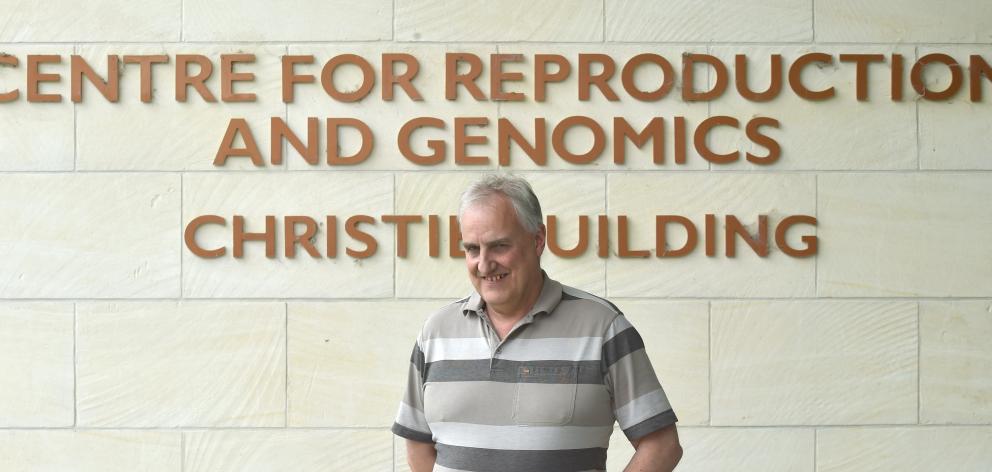
AgResearch Invermay-based principal scientist John McEwan was recently awarded a Science NZ lifetime achievement award at a function to mark 25 years of Crown Research Institutes.
Dr McEwan (61), who has been at Invermay since 1986, was internationally respected for his work in improving livestock genetics.
His nomination stated he had been a ``major force'' behind many initiatives aimed at improving the genetic merit of livestock, particularly sheep, and in other species in New Zealand, Australia and globally.
He has been the lead person in several international consortiums and published more than 280 publications.
While pleased with the recognition, Dr McEwan said he viewed it as a team award for the animal genomics group at Invermay.
Dr McEwan grew up on a sheep and beef farm in Southland, on part of the property his great-grandfather settled and developed from native bush after emigrating from Scotland.
His father, who died when Dr McEwan was in his mid-teens, was a gold miner during the Depression, trying his luck at Big Bay, north of Milford Sound, on the West Coast, where he met up with people such as Arawata Bill.
He was also interested in minerals and there was petrified wood and agate on the family farm near Tokanui.
Dr McEwan was very keen on geology and wanted to be a geologist. But when he went to the University of Otago in 1974, there had been a revolution in Chile and all the copper mines were taken over by the state.
It was a very tough time to be a geologist and there were no jobs, so he ended up studying chemistry and biochemistry.
An interest in genetics had been nurtured early by following the progress of his father's Romney sheep stud.
After a brief period teaching mathematics and science at James Hargest College, in Invercargill, Dr McEwan started a temporary position as a technician at the Woodlands research centre in Southland in 1978, working on trials involving sheep and lamb feeding and sheep production selection based on genetics.
His first job, he recalled, laughing, was not very glamorous - shovelling sheep manure out of the yards. After 18 months, he was appointed a scientist at Woodlands.
In 1985, Dr McEwan spent a year at Ireland's equivalent of AgResearch, looking at how Texel sheep compared with other breeds and the effects of some chemical compounds on animals.
Returning to New Zealand, he moved to Invermay where he has remained since. He now works three days a week.
He was involved with the establishment of both Sheep Improvement Ltd (SIL), which undertakes genetic evaluations for the New Zealand sheep industry, and the Central Progeny Test.
In the early 1990s, he recruited farmers to record parasite resistance traits, leading to the WormFEC breeding service.
He helped elucidate the Inverdale gene and helped Landcorp to verify, map and select the Carwell gene, leading to the LoinMAX test.
He also helped to confirm and map a gene for muscling effects, with three Texel breeders, leading to the MyoMAX test.
He identified the region for microphthalmia, a recessive defect in New Zealand Texels resulting in blindness, which led to the i-Scan test.
His work included sequencing genomes and building genotyping platforms including SNP chips and genotyping by sequencing methodologies.
Until recently, he was also co-leading the low methane emitting sheep breeding programme. He was still involved with a project looking at developing a cheap way of doing microbial profiling, with the idea of using it to predict such things as methane production, or feed efficiency, or other productive traits of the animal.
Until a decade ago, virtually all his work had been around sheep but it had become a bit wider in recent years.
At the moment, he was doing work with Norway in sheep and goats, China in sheep, Iceland with Atlantic salmon and also with other countries.
It was nice to develop something that was used in the industry. That could be ``a bit more tricky'' because it took a lot more work, he said.
``You can have a really great idea but, if it's at the wrong time, it won't work,'' he said.
``Lots of bits of technology'' had been developed in a research setting that most people did not realise had come from there, he said, citing the likes of the early electric fence developed at Ruakura.
Dr McEwan spoke fondly of those he had worked with over the years, saying he had been very lucky to have had bosses like Ken Drew, George Davis, Peter Fennessy and Allan Crawford. There had also been the other staff at AgResearch, some of whom had gone on to other areas. It had also been very fortunate having the University of Otago nearby, he said.